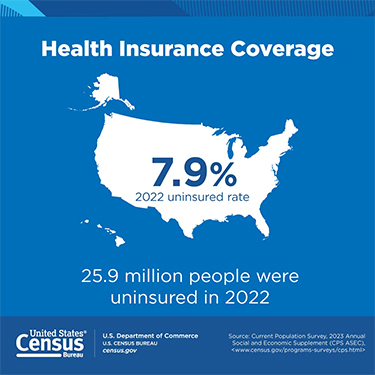The U.S. made important gains on measures of poverty, income and health coverage in 2022, a trio of new reports from the U.S. Census Bureau finds.
Health insurance coverage for people ages 19 to 64 improved in 2022, with increases in employer-based coverage helping drive uninsured rates from 11.6% to 10.8%, the new data show. Despite the gains, 25.9 million people still lacked health insurance coverage in 2022.
10.8%, the new data show. Despite the gains, 25.9 million people still lacked health insurance coverage in 2022.
Among working-age adults, 93.2% of white people had insurance coverage in 2022, versus 92.6% of Asian people, 88.6% of Black people and 76.6% of Hispanic people. The Midwest was the only U.S. region that did not experience a statistically significant increase in health insurance coverage.
Among other highlights from the Sept. 12 reports:
• U.S. income inequality declined for the first time since 2007. The real median household income fell 2.3% in 2022, dropping to $74,580.
• Poverty rates for Black adults and children reached a record low, but the overall U.S. rate was unchanged. Nearly 38 million people in the U.S. lived in poverty in 2022.
• The Supplemental Poverty Measure — which takes factors such as tax credits and public assistance into account — reached 12.4% in 2022, increasing from 7.8% in 2021. The end to child tax credits put into place during the height of the COVID-19 pandemic contributed to the increase, the bureau said.
• Social Security benefits kept 28.9 million people out of poverty in 2022. The Supplemental Nutritional Assistance Program, which helps low-income people afford food, helped lift 7.1 million people out of poverty.